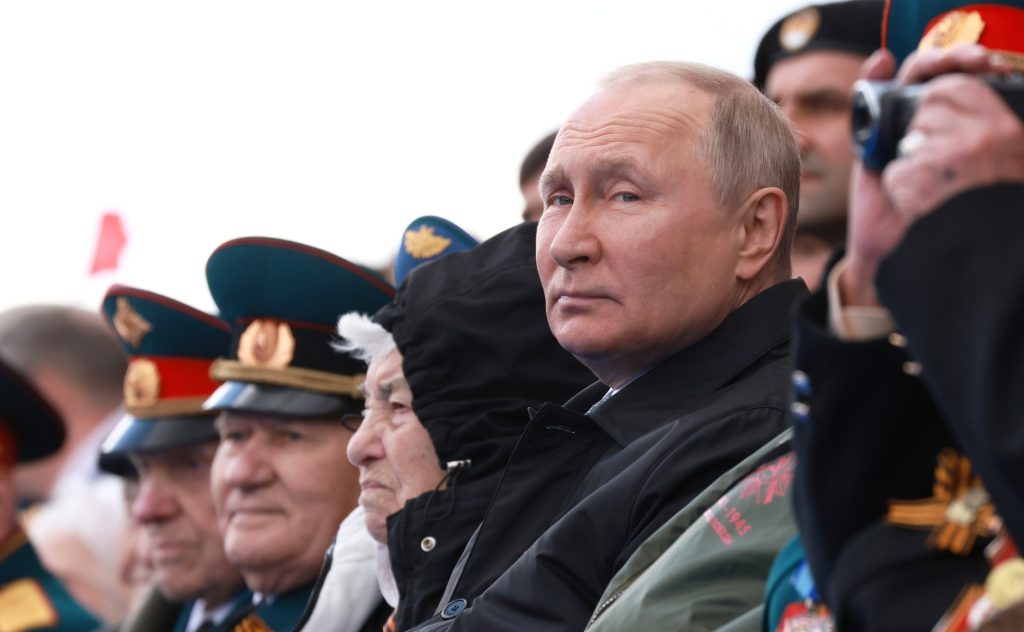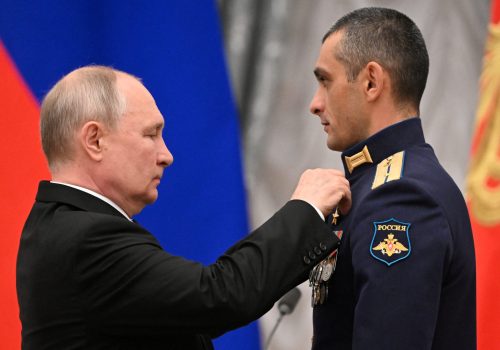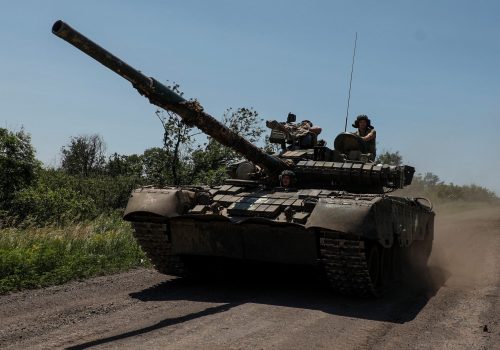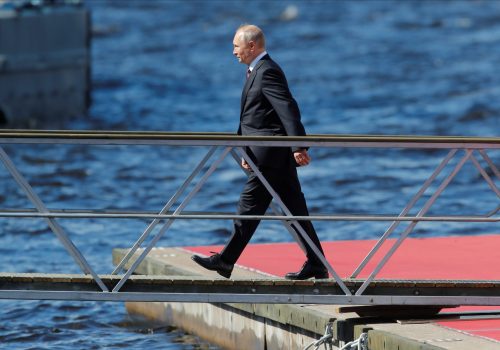While speaking at his security council on July 21, Russian President Vladimir Putin said that “the western territories of Poland are a gift from Stalin to the Poles.” What he did not say is that the Soviet Union annexed Poland’s eastern territories as part of its partition of the country with Nazi Germany as agreed to in the Molotov-Ribbentrop Pact, signed eighty-four years ago this week. On the eve of World War II, Moscow made the pact with what it saw as the pre-eminent power in Europe to divide smaller nations between them. Today, Russia is pursuing a similar ambition—with its invasion of Ukraine, the Kremlin is once again trying to expand its borders by force and make a bargain with a great power at the expense of the smaller country it seeks to conquer.
Some impatient Western leaders who don’t understand the difficulties inherent in attacking well-prepared defensive positions are fretting over the slow progress of Ukraine’s counteroffensive. This has led to increased discussion of a potential negotiated settlement to the conflict by political commentators and some officials. Russia will continue to seek a grand bargain with the United States on “European security” based on Moscow’s interests and without the input of the nations impacted, particularly Ukraine.
Thus, it is crucial that US politicians and diplomats fully include Kyiv in all peace negotiations with Russia. This also applies to any “track 2” or “track 1.5” dialogues. Otherwise, the United States would be reinforcing Moscow’s mistaken belief that—as it did in 1939 with Nazi Germany—it can engage in territorial horse-trading by coercing smaller nations and making bargains with larger ones. Moreover, Putin’s disregard for smaller nations’ sovereignty demonstrates that only security guarantees backed by military force can deter future Russian aggression against Ukraine.
Eventually, Ukraine and Russia must come to the table to agree some sort of terms to cease hostilities. But if Western leaders want these negotiations and their aftermath to be successful, they would do well to keep in mind the human cost of the Molotov-Ribbentrop Pact and the Kremlin’s rehabilitation of its logic.
Spheres of influence
On August 23, 1939, Germany and the Soviet Union signed what came to be known as the Molotov-Ribbentrop Pact after the Soviet and German foreign ministers, Vyacheslav Molotov and Joachim von Ribbentrop. To the world, it was a nonaggression pact. While many suspected the countries also conducted territorial horse-trading, it was not until the Nuremberg trials following World War II that the general population learned of the secret protocols that delineated Soviet and German “spheres of mutual interest in Eastern Europe.” The protocols partitioned Poland between the two powers while ceding Finland, the Baltic states, and Bessarabia (which had been part of Romania and largely aligns with modern-day Moldova) to the Soviet Union. Germany invaded western Poland roughly a week later, on September 1, 1939, and on September 17 the Soviet Union invaded eastern Poland. On September 22 the Soviet and Nazi militaries held a joint military parade in Brest-Litovsk.
Poland’s sovereignty was only the first domino that the Molotov-Ribbentrop Pact toppled. Two days after its parade with the Nazis in Brest-Litovsk, the Soviet Union turned its attention to the Baltic states and Finland, coercing all four to sign “mutual assistance treaties” that would allow the Soviet Union to base troops in their territory. The Baltic nations painfully acquiesced, while Finland’s refusal to sign led to the 1939-1940 Winter War. When Finland eventually ceded almost 10 percent of its territory to the Soviet Union to maintain its sovereignty, the Soviets turned their attention back to the Baltic states. While the Winter War was ongoing, the Soviets had already stationed troops in the small Baltic states. It used these troops’ presence and naval blockades to violate the precepts in the mutual assistance treaties that had guaranteed the Baltic states’ sovereignty by installing puppet governments that declared they wanted to join the Soviet Union. Following the Baltic nations’ annexation into the Soviet Union, tens of thousands of Balts were either killed or deported, and they did not regain their sovereignty until the fall of the Soviet Union.
Moscow has gone back and forth on whether and how to acknowledge the pact’s secret protocols. During the Cold War, the Soviet Union denied their existence. Under glasnost in 1989, the Soviet Union acknowledged the pact and released it from the archives. More recently, Putin has called the pact a necessary evil, and his Kremlin has sought to rehabilitate it, either by noting that dividing the world into spheres of influence was a common practice at the time or by blaming Poland, Estonia, and Latvia for the outbreak of World War II. Which brings us back to today.
The pact’s lessons for Ukraine
With both his words and actions, Putin demonstrates that he does not believe in the sovereignty of small nations. He believes in horse-trading between great powers, and so it is only a great power’s security guarantees and refusal to horse-trade that can deter him. Until Ukraine is in NATO, Ukrainians remain vulnerable to attack regardless of how many times Moscow’s leaders assure they will respect Ukrainian sovereignty.
Anything short of credible security guarantees for Ukraine will not deter Russia. The Budapest Memorandum provided assurances to Ukraine, and Russia invaded in 2014 anyway. The United States and its allies and partners ramped up economic and military assistance to Ukraine following the 2014 invasion, then again sharply in the months prior to February 2022. And still, Russia invaded. Promises to provide military and economic aid to Ukraine have not and will not deter future Russian invasions. Hoping that Russia will capitulate in the face of long-term US or Group of Seven (G7) economic commitments to Ukraine ignores Russia’s long history of being able to absorb pain and punishment to win. Indeed, it sees this as one of its greatest strengths vis-à-vis the United States and its democratic allies and partners.
To fully deter future Russian attacks, Ukraine must receive security guarantees backed up by a military enforcement mechanism. Ideally, this would mean NATO membership. Given the inherent political difficulties of bringing Ukraine into NATO, interim security guarantees on a bilateral or multilateral basis likely will be necessary. This might take the form of a multinational peacekeeping force, maritime security force escorting grain ships in the Black Sea, or something more akin to a Reconstruction Security Force. Whatever precise form it takes, it is imperative that any guarantee be backed by a credible military enforcement mechanism. As history shows, Moscow will respect nothing less.
Ann Marie Dailey is a nonresident senior fellow with the Atlantic Council’s Transatlantic Security Initiative, a policy researcher at RAND, and a captain in the US Army Reserves. She previously served as the senior advisor to the assistant secretary of defense for international security affairs.
The views expressed are those of the author and do not reflect the official position of RAND, the Department of the Army, or the Department of Defense.
Further reading
Fri, Aug 11, 2023
Why Putin’s Russia cannot accept its borders
UkraineAlert By
Vladimir Putin's attempts to justify the invasion of Ukraine as a just war to reunite historically Russian lands reflect the expansionist ideology at the heart of modern Russia's imperial identity, write Glenn Chafetz and John Sipher.
Thu, Jun 22, 2023
Ukraine’s counteroffensive is a marathon not a blitzkrieg
UkraineAlert By Peter Dickinson
Ukraine's summer counteroffensive has barely begun and already some are dismissing it as a failure due to lack of immediate progress. In reality, the unfolding campaign is a marathon and not a blitzkrieg, writes Peter Dickinson.
Thu, Aug 17, 2023
Putin must not be allowed to turn the Black Sea into a Russian lake
UkraineAlert By Melinda Haring
Western countries must take urgent action to prevent Vladimir Putin from turning the Black Sea into a Russian lake, warns Melinda Haring.
Image: In the photos taken on May 9, 2022, the President of Russia, Vladimir Putin, attended a military parade as part of the 77th anniversary of the Victory over Nazi Germany in World War II. The parade, held on Red Square in central Moscow, commemorates the 1945 victory with a display of his military might as his army battles Kyiv's forces in eastern Ukraine.



